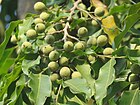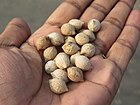Note: This is a project under development. The articles on this wiki are just being initiated and broadly incomplete. You can Help creating new pages.
Difference between revisions of "Putranjiva roxburghi - Putranjiva"
(→Identification) |
|||
| (11 intermediate revisions by 2 users not shown) | |||
| Line 1: | Line 1: | ||
[[File:Menasinakale (Kannada- ಮೆಣಸಿನಕಲೆ) (8729331614).jpg|thumb|right|''Putranjivah'', ''Putranjiva roxburghii'']] | [[File:Menasinakale (Kannada- ಮೆಣಸಿನಕಲೆ) (8729331614).jpg|thumb|right|''Putranjivah'', ''Putranjiva roxburghii'']] | ||
'''Putranjivah''' is an evergreen tree with graceful hanging branches and dark green leaves. Its seeds have long been used in Ayurveda. | '''Putranjivah''' is an evergreen tree with graceful hanging branches and dark green leaves. Its seeds have long been used in Ayurveda. | ||
| − | |||
==Uses== | ==Uses== | ||
{{Uses|Aphrodisiac}}, {{Uses|Gastritis}}, {{Uses|Burning sensation in eyes}}, {{Uses|Relieves thirst}} | {{Uses|Aphrodisiac}}, {{Uses|Gastritis}}, {{Uses|Burning sensation in eyes}}, {{Uses|Relieves thirst}} | ||
| Line 10: | Line 9: | ||
==Chemical Composition== | ==Chemical Composition== | ||
| + | Ethanol extraction of the fresh leaves of P. roxburghii proved convenient for the isolation of polyphenolic compounds. In addition to triterpenoids this extract yielded ellagic acid, gallic acid, gallocatechin, ellagi-and gallo-tannins and saponins. The main components of the root bark were triterpenoids, friedelin, putranjivadione, roxburgholone, methyl putrate and saponins derived from oleanolic acid. | ||
==Common names== | ==Common names== | ||
| − | {{Common names|kn=Amaami, Amani, Kaal damani, Menasina kaale, Putranjeeva|ml=Pongolan, Ponkalam, Putranjivi, Puttilanni|sa=Aksaphala, Kumarbeeja, Putrajivah, Putranjiva|ta=Karuppilai, Kattuppacceri Maram, Pongolam |te=Kadrajuvi, Kudrajinic, Kudurujuvir, Kudurujuvvi, Putra jeevi|hi=Jiaputa, Jivputrak, Jiyapota, Putranjiva | + | {{Common names|kn=Amaami, Amani, Kaal damani, Menasina kaale, Putranjeeva|ml=Pongolan, Ponkalam, Putranjivi, Puttilanni|sa=Aksaphala, Kumarbeeja, Putrajivah, Putranjiva|ta=Karuppilai, Kattuppacceri Maram, Pongolam |te=Kadrajuvi, Kudrajinic, Kudurujuvir, Kudurujuvvi, Putra jeevi|hi=Jiaputa, Jivputrak, Jiyapota, Putranjiva}} |
<ref name="Common names"/> | <ref name="Common names"/> | ||
| Line 36: | Line 36: | ||
==Identification== | ==Identification== | ||
===Leaf=== | ===Leaf=== | ||
| − | {{Leaf|Simple| | + | {{Leaf|Simple|Alternate|Stipule small, lateral, caducous; petiole 5-7 mm long, slender, pubescent; lamina 3.5-12 x 1.5-4.5 cm, elliptic-oblong, base oblique, apex shortly acuminate}}<ref name="Leaf"/> |
===Flower=== | ===Flower=== | ||
| − | {{Flower|Unisexual| | + | {{Flower|Unisexual|Axillary spikes|Yellow||Flowers unisexual, small, yellow; male flowers: sessile, in axillary spikes, 2-2.5 mm across; pedicels 1.5-2 mm long, glabrous.}} |
===Fruit=== | ===Fruit=== | ||
| − | {{Fruit|A drupe|1.3-2 x 1.5 cm| | + | {{Fruit|A drupe|1.3-2 x 1.5 cm|Ovoid-ellipsoid, white tomentose; seed one, crustaceous; pedicels 6-25 mm long|}} |
===Other features=== | ===Other features=== | ||
| Line 54: | Line 54: | ||
==How to plant/cultivate== | ==How to plant/cultivate== | ||
| − | + | This species is usually dioecious, though occasional monoecious forms are found. Generally, both male and female forms need to be grown if fruit and seed are required. | |
| − | |||
| − | |||
| − | |||
| − | |||
| − | |||
| − | |||
| − | |||
==Commonly seen growing in areas== | ==Commonly seen growing in areas== | ||
| Line 77: | Line 70: | ||
<references> | <references> | ||
| − | <ref name="Uses">https://easyayurveda.com/2017/04/20/putrajivaka-putranjiva-roxburghii/ | + | <ref name="Uses">[https://easyayurveda.com/2017/04/20/putrajivaka-putranjiva-roxburghii/ Uses]</ref> |
| − | <ref name="Leaf">[http://keralaplants.in/flowering-plants-kerala-dvd.aspx | + | <ref name="Leaf">[http://keralaplants.in/flowering-plants-kerala-dvd.aspx BOTANIC DESCRIPTION]</ref> |
| − | <ref name="Common names">[http://envis.frlht.org/bot_search | + | <ref name="Common names">[http://envis.frlht.org/bot_search Vernacular names]</ref> |
| Line 90: | Line 83: | ||
[[Category:Herbs]] | [[Category:Herbs]] | ||
| − | [[Category:Plants of western ghats]][[Category: | + | [[Category:Plants of western ghats]][[Category:Euphorbiaceae]] |
Latest revision as of 10:31, 20 July 2020
Putranjivah is an evergreen tree with graceful hanging branches and dark green leaves. Its seeds have long been used in Ayurveda.
Contents
- 1 Uses
- 2 Parts Used
- 3 Chemical Composition
- 4 Common names
- 5 Properties
- 6 Habit
- 7 Identification
- 8 List of Ayurvedic medicine in which the herb is used
- 9 Where to get the saplings
- 10 Mode of Propagation
- 11 How to plant/cultivate
- 12 Commonly seen growing in areas
- 13 Photo Gallery
- 14 References
- 15 External Links
Uses
Aphrodisiac, Gastritis, Burning sensation in eyes, Relieves thirst [1]
Parts Used
Chemical Composition
Ethanol extraction of the fresh leaves of P. roxburghii proved convenient for the isolation of polyphenolic compounds. In addition to triterpenoids this extract yielded ellagic acid, gallic acid, gallocatechin, ellagi-and gallo-tannins and saponins. The main components of the root bark were triterpenoids, friedelin, putranjivadione, roxburgholone, methyl putrate and saponins derived from oleanolic acid.
Common names
| Language | Common name |
|---|---|
| Kannada | Amaami, Amani, Kaal damani, Menasina kaale, Putranjeeva |
| Hindi | Jiaputa, Jivputrak, Jiyapota, Putranjiva |
| Malayalam | Pongolan, Ponkalam, Putranjivi, Puttilanni |
| Tamil | Karuppilai, Kattuppacceri Maram, Pongolam |
| Telugu | Kadrajuvi, Kudrajinic, Kudurujuvir, Kudurujuvvi, Putra jeevi |
| Marathi | NA |
| Gujarathi | NA |
| Punjabi | NA |
| Kashmiri | NA |
| Sanskrit | Aksaphala, Kumarbeeja, Putrajivah, Putranjiva |
| English | NA |
Properties
Reference: Dravya - Substance, Rasa - Taste, Guna - Qualities, Veerya - Potency, Vipaka - Post-digesion effect, Karma - Pharmacological activity, Prabhava - Therepeutics.
Dravya
Rasa
Madhura (Sweet), Katu (Pungent)
Guna
Guru (Heavy), Picchila (Slimy)
Veerya
Sheeta (cold)
Vipaka
Karma
Pitta, Vata
Prabhava
Habit
Identification
Leaf
| Kind | Shape | Feature |
|---|---|---|
| Simple | Alternate | Stipule small, lateral, caducous; petiole 5-7 mm long, slender, pubescent; lamina 3.5-12 x 1.5-4.5 cm, elliptic-oblong, base oblique, apex shortly acuminate |
Flower
| Type | Size | Color and composition | Stamen | More information |
|---|---|---|---|---|
| Unisexual | Axillary spikes | Yellow | Flowers unisexual, small, yellow; male flowers: sessile, in axillary spikes, 2-2.5 mm across; pedicels 1.5-2 mm long, glabrous. |
Fruit
| Type | Size | Mass | Appearance | Seeds | More information |
|---|---|---|---|---|---|
| A drupe | 1.3-2 x 1.5 cm | Ovoid-ellipsoid, white tomentose; seed one, crustaceous; pedicels 6-25 mm long | {{{5}}} | {{{6}}} |
Other features
List of Ayurvedic medicine in which the herb is used
Where to get the saplings
Mode of Propagation
How to plant/cultivate
This species is usually dioecious, though occasional monoecious forms are found. Generally, both male and female forms need to be grown if fruit and seed are required.
Commonly seen growing in areas
Tropical area, Sub Tropical area
Photo Gallery
References
External Links
- Ayurvedic Herbs known to be helpful to treat Aphrodisiac
- Ayurvedic Herbs known to be helpful to treat Gastritis
- Ayurvedic Herbs known to be helpful to treat Burning sensation in eyes
- Ayurvedic Herbs known to be helpful to treat Relieves thirst
- Herbs with Seeds used in medicine
- Herbs with Leaves used in medicine
- Herbs with common name in Kannada
- Herbs with common name in Hindi
- Herbs with common name in Malayalam
- Herbs with common name in Tamil
- Herbs with common name in Telugu
- Herbs with common name in Sanskrit
- Habit - Tree
- Index of Plants which can be propagated by Seeds
- Index of Plants which can be propagated by Cuttings
- Herbs that are commonly seen in the region of Tropical area
- Herbs that are commonly seen in the region of Sub Tropical area
- Herbs
- Plants of western ghats
- Euphorbiaceae




